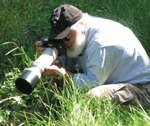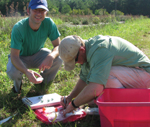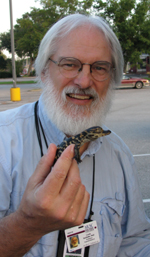|
By Dawn
Brazell
Public Relations
They have it
down to a science. They all know
the jaws and the tail pose the
biggest threat. After the trapped
alligator is hauled onto the
shore, Louis J. Guillette, Ph.D.,
climbs on top and, with the help
of assistants, secures the
powerful jaws with several rubber
bands.
Putting a towel
over the alligator's eyes, the
thrashing stops. It's a trick the
researcher, who holds a
SmartState endowed chair in
Marine Genomics, has learned calms
the alligators. This is better for
all involved and makes it easier
for the team to quickly get blood
and urine samples and tag the
animal, so he can be released back
into the wild.
 Phil Wilkinson,
formerly with the S.C.
Department of Natural Resources,
helps Dr. Louis J. Guillette
(center) and Dr. Thomas
Rainwater get field samples
during research at the Tom
Yawkey Wildlife Center Heritage
Preserve. To watch a video,
visit
http://bit.ly/DrLouisGuillette. Phil Wilkinson,
formerly with the S.C.
Department of Natural Resources,
helps Dr. Louis J. Guillette
(center) and Dr. Thomas
Rainwater get field samples
during research at the Tom
Yawkey Wildlife Center Heritage
Preserve. To watch a video,
visit
http://bit.ly/DrLouisGuillette.
Swarms of
mosquitoes cover the researchers
as they collect these samples at
the Tom Yawkey Wildlife Center
Heritage Preserve, home to 31
square miles of marshland and a
favorite hangout for the
alligators. It's where they found
the hatchling rate to be 68
percent, about 22 percent below
what it should be.
One of a new
breed of scientist, Guillette does
much of his laboratory work in the
wild. This means he has had to get
creative from figuring out
innovative testing kits for field
research, to repurposing dog
catheters, to getting urine
samples from alligators.
It's one reason
it was announced Sept. 13 that
Guillette, a reproductive
biologist, endocrinologist and
professor of obstetrics and
gynecology, is to receive a
$100,000 Heinz Award for his
pioneering research into toxic
chemicals' impact on wildlife and
human health. He is being
recognized for his research
showing how alligators can
function as a sentinel species for
environmental contamination.
 Guillette, who
provides community talks to
raise awareness about his
research, uses his photography
skills to augment his work in
the field. Guillette, who
provides community talks to
raise awareness about his
research, uses his photography
skills to augment his work in
the field.
Guillette said
he was 'blown away' by the news.
"When you get an award on this
level, you realize you have
colleagues who respect your work,"
he said, adding that it was a
humbling experience to look at
former recipients. He said
it's an award not just for him but
for his laboratory and the
colleagues with whom he
collaborates, a critical key to
today's successful scientists.
"Modern science is not done by
individuals. Modern science is
done by teams."
He's thankful
for the award in that it helps
convince funding agencies to
support the kind of science he's
doing. Some agencies may see it as
being a risky area.
"It validates
what we continue to do – that we
continue to fight to do not just
the science but to take that
science and have it used to make a
difference in other fields and in
policy. I still believe that
individuals can make a
difference."
Though medical science looks at
nutrition and the workplace as
environmental factors affecting
health, other areas have been
largely ignored, he said. "There
are environmental contaminants
that we all are exposed to
chronically at relatively low
concentrations, but they are
chronic exposures from conception
to death. What is the implication
of that? Right now there are not
many people in the field of
medicine who really think about
that."
Guillette's
joint appointment in MUSC's
Department of Obstetrics and
Gynecology and the Marine
Biomedicine and Environmental
Sciences Center at the Hollings
Marine Lab is one way to start
changing that.
 Guillette and his
team release 80 baby alligators
back to their home in the Tom
Yawkey Wildlife Center Heritage
Preserve. Guillette and his
team release 80 baby alligators
back to their home in the Tom
Yawkey Wildlife Center Heritage
Preserve.
Guillette said
the major breakthroughs in
medicine often happen at the
interfaces of disciplines. "That's
why today you have mathematicians
and engineers working with
geneticists to develop the next
approach to how do we study
genetic codes – how do we study
genomes. We have bioengineers
working with cardiologists working
with developmental biologists to
discover how to repair a heart –
not a bionic heart – how do we
actually make the tissue to
implant into the heart."
In his area, he
gets to combine the fields of
wildlife, genetics, reproductive
biology and the environment.
Studying wild populations with
true genetic diversity and
exposure to a region's
environmental surroundings will
yield very different results from
a scientific model using inbred
mice, he said. "Being a biologist,
I'm interested in understanding
the biology of the beast. The
second part of the issue is the
sentinel species aspect – what can
that animal tell us about the
health of the environment and our
own health? At the level of the
genes – an ovary is an ovary and a
testes is a testes. What is the
gene-by-environment interaction?"
 Researchers Drs.
Benjamin Parrott and Thomas
Rainwater store samples and
record field measurements from
two male alligators. Researchers Drs.
Benjamin Parrott and Thomas
Rainwater store samples and
record field measurements from
two male alligators.
Guillette has
made important finds into how
contaminants affect gene
regulation or how they get turned
on and off. In winning the Heinz
Award, Teresa Heinz of the Heinz
Family Foundation cited his work
in the field of endocrine
disruption. "His research on
alligators and other marine life
created an in-depth model for
understanding the effects of
toxins in the wild and provides
information we need to safeguard
people and wildlife," she said.
Guillette is a
leader in the field of hormone
disruption, which has emerged as a
major public health threat during
the past two decades. He has
researched environmental estrogens
for years, believing they could be
responsible for dropping
population levels and reproductive
abnormalities in wildlife living
in the waters of Florida. In the
late 1980s, he and his team
discovered that DDT and other
chemicals in Lake Apopka in
Florida were creating ovarian and
genital abnormalities by
manipulating their hormones.
Later, he demonstrated that even
low-level exposures to one or
multiple environmental
contaminants during critical
periods of fetal development can
have long-lasting health
implications.
 Guillette holds one
of the alligators that hatched
out at the Hollings Marine
Laboratory. Guillette holds one
of the alligators that hatched
out at the Hollings Marine
Laboratory.
His research
raised red flags about what
potential impacts chemicals also
may have on human reproductive
health, especially as other
researchers have shown that sperm
counts have dropped and testicular
cancer is on the rise. Guillette's
studies demonstrate that there is
a direct link between
environmental chemicals and male
and female reproductive
health.
"I have little
doubt that environmental
contaminants are a significant
part of the reason we are today
seeing an increase in many
diseases of the reproductive
system in wildlife and humans,"
said Guillette. "The only question
is, 'What are we going to do about
it?' "
|



 Phil Wilkinson,
formerly with the S.C.
Department of Natural Resources,
helps Dr. Louis J. Guillette
(center) and Dr. Thomas
Rainwater get field samples
during research at the Tom
Yawkey Wildlife Center Heritage
Preserve. To watch a video,
visit
Phil Wilkinson,
formerly with the S.C.
Department of Natural Resources,
helps Dr. Louis J. Guillette
(center) and Dr. Thomas
Rainwater get field samples
during research at the Tom
Yawkey Wildlife Center Heritage
Preserve. To watch a video,
visit  Guillette, who
provides community talks to
raise awareness about his
research, uses his photography
skills to augment his work in
the field.
Guillette, who
provides community talks to
raise awareness about his
research, uses his photography
skills to augment his work in
the field. Guillette and his
team release 80 baby alligators
back to their home in the Tom
Yawkey Wildlife Center Heritage
Preserve.
Guillette and his
team release 80 baby alligators
back to their home in the Tom
Yawkey Wildlife Center Heritage
Preserve. Researchers Drs.
Benjamin Parrott and Thomas
Rainwater store samples and
record field measurements from
two male alligators.
Researchers Drs.
Benjamin Parrott and Thomas
Rainwater store samples and
record field measurements from
two male alligators. Guillette holds one
of the alligators that hatched
out at the Hollings Marine
Laboratory.
Guillette holds one
of the alligators that hatched
out at the Hollings Marine
Laboratory.